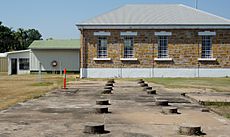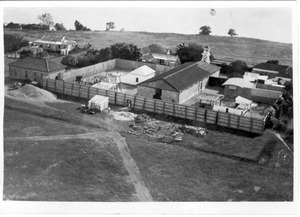Fannie Bay Gaol facts for kids
 |
|
| Location | Fannie Bay, Northern Territory |
|---|---|
| Status | Closed |
| Security class | Minimum and Maximum Security |
| Capacity | ? |
| Opened | 1883 |
| Closed | 1979 |
| Managed by | Northern Territory Department of Community Development, Sport & Cultural Affairs |
Fannie Bay Gaol is a historic prison located in Fannie Bay, Northern Territory, Australia. It was known as Her Majesty's Gaol and Labour Prison. This important building operated from September 20, 1883, until September 1, 1979. Glen Sutton was the last person in charge of Fannie Bay Gaol. He then became the first leader of the new prison in Berrimah.
Contents
A Look Back at Fannie Bay Gaol
Early Days and Art
Fannie Bay Gaol has a long and interesting history. In 1888, a man named John George Knight was a Deputy Sheriff. This meant he helped keep law and order. He later became a Government Resident, a key leader in the area. Knight collected drawings made by Aboriginal prisoners. These drawings were shown at the Melbourne Centennial Exhibition. This event was called "The Dawn of Art." Experts believe this was the first public display of Aboriginal art.
Important Events and Changes
The prison was damaged by Cyclone Tracy in 1974. This powerful storm caused a lot of damage across Darwin.
At first, women prisoners stayed in the Gaoler's (prison manager's) home. But in 1928, a special section for women was built. This meant male and female prisoners were kept in separate buildings. The women's prison even had a small garden. This garden helped keep the prisoners busy. There was also a block for children. In the early 1970s, this area also housed refugees. These were people who had arrived by boat seeking safety.
Prison Design and Security
Fannie Bay Gaol had different types of cells. Two special cells were placed in the middle of the lawn. These were for inmates who were very difficult or had mental health issues. These cells had a small yard with strong fencing. Maximum security cells were designed to be very secure. They had hooks on the walls to hold inmates. Their doorways were very narrow. This made it harder for inmates to escape when a guard entered.
From Prison to Museum
Fannie Bay Gaol is an important historical site. It was listed on the Northern Territory Heritage Register in 1995. This means it is protected for its historical value. On September 1, 1979, all prisoners moved to a new facility in Berrimah. The gaol officially closed in October 1980. Today, Fannie Bay Gaol is a museum. Visitors can explore the old prison and learn about its past.
People Connected to Fannie Bay Gaol
Notable Figures
- Harold Nelson was a politician. He was imprisoned in 1921. This was because of his campaign called 'no taxation without representation'. This campaign helped lead to the Darwin Rebellion.
- Nemarluk was a man who avoided capture for a long time. He was wanted for the death of three Japanese fishers in 1930. He escaped from prison once but was later caught. He passed away from illness while serving his time.
- Ray Raiwala was involved in a case at Milingimbi. He was later released in 1934. This happened because the court recognized the rights of people to practice traditional law.
See also
- List of Australian prisons
- List of people legally executed in the Northern Territory


